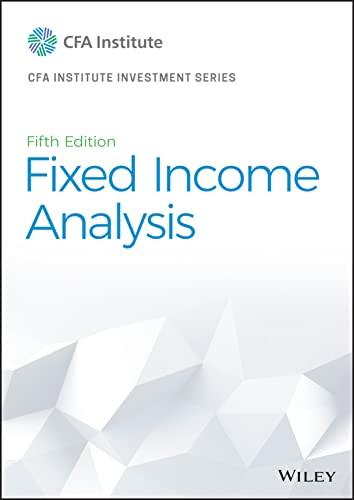A corporation is concerned about the defined benefit pension plan that it sponsors for its unionized employees.
Question:
A corporation is concerned about the defined benefit pension plan that it sponsors for its unionized employees. Because of recent declines in corporate bond yields and weak performance in its equity investments, the plan finds itself to be only about 80% funded based on the PBO measure. That fact is raising concerns with its employees as well as with the rating agencies. Currently, the present value of the corporation’s retirement obligations is estimated by the plan’s actuarial advisers to be about USD 1.321 billion using the PBO measure of liabilities. The corporation has no plans to close the defined benefit plan but is concerned about having to report the funding status in its financial statements. The market value of its asset portfolio is USD 1.032 billion—the plan is underfunded by USD 289 million.
The pension fund’s asset allocation is rather aggressive: 70% equity, 10% alternative assets, and 20% fixed income. The fund manager hopes that a recovering equity market will reverse the deficit and ultimately return the plan to a fully funded position. Still, the manager is concerned about tightening corporate spreads as the economy improves. That scenario could lead to lower discount rates that are used to calculate the present value of the liabilities and offset any gains in the stock market. The actuarial advisers to the plan estimate that the effective duration of the liabilities is 9.2, so the BPV is USD 1.215 million. The corporate sponsor requires that the manager assume an effective duration of zero on equity and alternative assets. The fixed-income portfolio consists mostly of long-term bonds, including significant holdings of zero-coupon government securities. Its effective duration is estimated to be 25.6. Taken together, the asset BPV is USD 528,384. The negative money duration gap is substantial.
The pension plan has hired a qualified professional asset manager (QPAM) to offer advice on derivatives overlay strategies and to execute the contracts with a commercial bank. The QPAM suggests that the pension plan consider the use of interest rate derivatives to partially close the duration gap between its assets and liabilities.
The QPAM has identified three interest rate derivatives strategies that can be executed with the commercial bank. The first is a 30-year, 3.80% receive-fixed swap referencing the three-month MRR. The swap’s effective duration is +17.51, and its BPV is 0.1751 per USD 100 of notional principal. The second is a receiver swaption having a strike rate of 3.60%. The plan pays a premium of 145 bps up front to buy the right to enter a 30-year swap as the fixed-rate receiver. The expiration date is set to match the date when the pension plan next reports its funding status. The third is a swaption collar, the combination of buying the 3.60% receiver swaption and writing a 4.25% payer swaption. The premiums on the two swaptions offset, so this is a “zero-cost” collar.
After some discussions with the rates desk at the commercial bank and a conversation with the bank’s strategy group, the plan manager instructs the QPAM to select the 3.80% receive-fixed interest rate swap. Moreover, the manager chooses a hedging ratio of 75%.
Indicate the plan manager’s likely view on future 30-year swap fixed rates given the decision to choose the swap rather than the purchased receiver swaption or the swaption collar.
Step by Step Answer:






